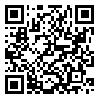Volume 7, Issue 3 (Summer 2018)
Arch Hyg Sci 2018, 7(3): 208-215 |
Back to browse issues page
Download citation:
BibTeX | RIS | EndNote | Medlars | ProCite | Reference Manager | RefWorks
Send citation to:



BibTeX | RIS | EndNote | Medlars | ProCite | Reference Manager | RefWorks
Send citation to:
Mosavianasl Z, Nemati Ajvadi A, Babayi Pouya A. Evaluation of Workplaces and Corrective Actions in the Central Iranian Steel Industries. Arch Hyg Sci 2018; 7 (3) :208-215
URL: http://jhygiene.muq.ac.ir/article-1-346-en.html
URL: http://jhygiene.muq.ac.ir/article-1-346-en.html
1- Ahvaz Jundishapur University of Medical Sciences
2- Department of Occupational Health Engineering, School of Public Health, Ardabil University of Medical Sciences, Ardabil, Iran.
3- Department of Occupational Health Engineering, School of Health, Ardabil University of Medical Sciences, Ardabil, Iran.
2- Department of Occupational Health Engineering, School of Public Health, Ardabil University of Medical Sciences, Ardabil, Iran.
3- Department of Occupational Health Engineering, School of Health, Ardabil University of Medical Sciences, Ardabil, Iran.
Abstract: (3736 Views)
| Background & Aims of the Study: Musculoskeletal disorders (MSD) are one of the important occupational health issues. Prevention of these discomforts requires posture assessment at work stations using ergonomic job analysis methods. The purpose of the present study is to evaluate the work stations and perform corrective actions in one of the central steel industries of Iran to decrease the frequency of these disorders. Materials and Methods: An Interventional and analytical study were performed at 29 stations on one central steel industries in Iran in 2017. Initially, a primary assessment was done by using RULA method, and after calculating the possibility of musculoskeletal disorders, corrective actions were taken at high risk sites. Results: In the present study, all participants male with a mean age 33.9 years. The final evaluation of scores at different work stations indicated that 17% of the stations with a risk of level 1, 59% had a risk level of 2, 17% of risk level 3, and 0.07% of risk rate 4. Principally, the consequences of the initial evaluation of the RULA technique are based on the establishment of the "waste breakdown" and "demolition work" duties at risk level 4, which makes changes and ergonomic intervention immediately necessary. |
Type of Study: Original Article |
Subject:
Occuptional Health
Received: 2018/06/9 | Accepted: 2018/09/19 | Published: 2018/10/7
Received: 2018/06/9 | Accepted: 2018/09/19 | Published: 2018/10/7
References
1. Gordon C, Johnson EW, Gatens PF, Ashton JJ. Wrist ratio correlation with carpal tunnel syndrome in industry. American journal of physical medicine & rehabilitation. 1988;67(6):270-2.
2. Habibi E, KARIMI S, HASANZADEH A. Evaluation of ergonomic risk factors by OCRA method in assembly industry. 2008.
3. Tayyari F, Smith J. A text book on occupational ergonomics 1st edition. Chapman & Hall, Madras, India; 1997.
4. Karwowski W, Marras WS. Fundamentals and Assessment Tools for Occupational Ergonomics: Crc Press; 2006.
5. Nasl Saraji J, Ghaffari M, Shahtaheri S. Survey of correlation between two evaluation method of work related musculoskeletal disorders risk factors REBA& RULA. Iran Occupational Health. 2006;3(2):5-0.
6. Putz-Anderson V, Bernard BP, Burt SE, Cole LL, Fairfield-Estill C, Fine LJ, et al. Musculoskeletal disorders and workplace factors. National Institute for Occupational Safety and Health (NIOSH). 1997;104.
7. Asadi N, Choobineh A, Keshavarzi S, Daneshmandi H. A comparative assessment of manual load lifting using NIOSH equation and WISHA index methods in industrial workers of Shiraz City. Journal of health sciences and surveillance system. 2015;3(1):8-12.
8. McAtamney L, Corlett EN. RULA: a survey method for the investigation of work-related upper limb disorders. Applied ergonomics. 1993;24(2):91-9. [DOI:10.1016/0003-6870(93)90080-S]
9. Barkhordari A, Jafari Nodoushan R, Vatani Shoaa J, Halvani G, Salmani Nodoushan M. Posture Evaluation Using OWAS, RULA, QEC Method in FERO-ALEAGE Factory Workers of Kerman. Occupational Medicine Quarterly Journal. 2011;2(1):14-9.
10. Ghasemkhani M, Azam K, Aten S. Evaluation of ergonomic postures of assembling unit workers by Rapid Upper Limb Assessment. Hakim Research Journal. 2007;10(2):28-33.
11. VARMAZYAR S, TORKAMAN F, AHMADI S, ZAREI F. ASSESSMENT OF LABOR SITUATION AND PREVALENCE OF MUSCULAR-SKELETON DISORDERS AMONG CHAIN GROCERY STORE WORKERS IN QAZVIN IN 2009 AND APPLIED CONTROL SUGGESTION. 2010.
12. Malchaire J, Cock N, Vergracht S. Review of the factors associated with musculoskeletal problems in epidemiological studies. International archives of occupational and environmental health. 2001;74(2):79-90. [DOI:10.1007/s004200000212]
13. Aghilinejad M, Choobineh A, Sadeghi Z, Nouri M, Ahmadi AB. Prevalence of musculoskeletal disorders among Iranian steel workers. Iranian Red Crescent Medical Journal. 2012;14(4):198.
14. Mean V, Abdullah NS, Dawal M, Zawiah S, Aoyama H, Sothea K, editors. Investigation on Musculoskeletal Symptoms and Ergonomic Risk Factors at Metal Stamping Industry. Advanced Engineering Forum; 2013: Trans Tech Publ. [DOI:10.4028/www.scientific.net/AEF.10.293]
15. Mo'tamed-Zadeh M, Shafiei-Motlagh M, Darvishi E. Ergonomics intervention in unit blast furnace of a typical steel company. Archives of Rehabilitation. 2013;14(3):80-7.
16. Kushwaha DK, Kane PV. Ergonomic assessment and workstation design of shipping crane cabin in steel industry. International Journal of Industrial Ergonomics. 2016;52:29-39. [DOI:10.1016/j.ergon.2015.08.003]
17. Habibi E, Poorabdian S, Ahmadinejad P, Hassanzadeh A. Ergonomic risk assessment by REBA method. Iran Occupational Health. 2007;4(3):35-43.
18. Soleimani E, Daneshmandi H, Mohamadbeigi A, Izadi K. Prevalence of musculoskeletal disorders and posture analysis using RULA method in Shiraz general dentists in 2010. Journal of Islamic Dental Association of Iran. 2013;25(1):35-40.
19. Saremi M, Lahmi M, Faghihzadeh S.The effect of ergonomic intervention intervention on dentists musculoskeletal disorders. Daneshvar Medicine. 2006;13(64):55-62.
Send email to the article author
| Rights and permissions | |
 |
This work is licensed under a Creative Commons Attribution-NonCommercial 4.0 International License. |









